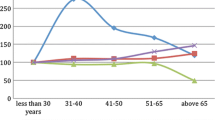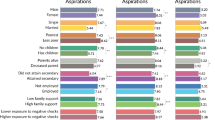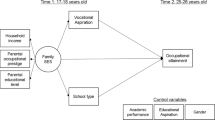Abstract
Many studies have examined the effect of life events, education, and income on well-being. Conversely, research concerning well-being as a predictor of life course outcomes is sparse. Diener’s suggestion “to inquire about the effects of well-being on future behavior and success” has, with some exceptions, not yet come to fruition. This article contributes to this body of research. We conceptualize and analyze the interplay between educational achievement, occupational success, and well-being as a complex process. The relationship between these domains is examined drawing on a structure-agency framework derived from Bourdieu and Social Comparison Theory. Social comparison between adolescents and their parents is suggested to be the mechanism explaining the effects of successful and unsuccessful intergenerational transmission of educational achievement and occupational success on well-being. It is further argued that well-being may serve as an individual resource by fostering educational and occupational outcomes. Panel data from the Transition from Education to Employment (TREE) project, a Swiss PISA 2000 follow-up study, was used. The interplay between well-being and successful and unsuccessful intergenerational transfer of educational attainment was analyzed in an autoregressive cross-lagged mixture model framework. Social comparison was found to be related to well-being, while well-being proved to significantly increase the probability of successful intergenerational transfer of educational attainment.


Similar content being viewed by others
Notes
Dual VET refers to the most common form of VET programs in Switzerland, where students spend some days of the week at a vocational school and some day at a host company.
TREE has been running since 2000 and has been funded by the Swiss National Science Foundation, the University of Basel, the Swiss Federal Office of Statistics, the Federal Office of Professional Education and Technology, and the cantons of Berne, Geneva, and Ticino.
Higher order autocorrelation was assumed to be constant over classes. Not shown in Table 1. Average autocorrelation is 0.13 over all waves.
Intercepts of positive attitude toward life differ also over time and between classes, but not significantly.
In Switzerland, teenage pregnancy rates are comparably low. Births by mothers of 15 to 19 years accounted for only 1.0% of all births in Switzerland between 2001 and 2007 (20 to 24 years for 10.3%; calculations based on Federal Statistical Office data (2011)).
References
Adams, R., & Wu, M. (Eds.). (2002). PISA 2000 technical report. Paris: OECD/PISA.
Amos, J. (1994). L’entrée en apprentissage: nouvelles modalités. Panorama, 1994(29), 6–8.
Amos, J. (1995). Entrée en apprentissage et nouvelle demande sociale de formation. Panorama, 1994(33), 3–5.
Annen, L., et al. (2011). Swiss education report 2010. Aarau: SKBF, CSRE Swiss Coordination Centre for Research in Education.
Bandura, A. (1989). Regulation of cognitive processes through perceived self-efficacy. Developmental Psychology, 25(5), 729–735.
Bast, J., & Reitsma, P. (1998). Analyzing the development of individual differences in terms of Matthew effects in reading: Results from a Dutch longitudinal study. Developmental Psychology, 34(6), 1373–1399.
Blau, P. M., & Duncan, O. D. (1967). The American occupational structure. New York: Wiley.
Blore, J., Stokes, M., Mellor, D., Firth, L., & Cummins, R. (2011). Comparing multiple discrepancies theory to affective models of subjective wellbeing. Social Indicators Research, 100(1), 1–16.
Blossfeld, H.-P., & Shavit, Y. (1993). Persisting barriers. Changes in educational opportunities in thirteen countries. In Y. Shavit & H.-P. Blossfeld (Eds.), Persistent inequality: Changing educational attainment in thirteen countries. San Francisco: Westview-Press.
Boes, S., Staub, K., & Winkelmann, R. (2010). Relative status and satisfaction. Economics Letters, 109(3), 168–170.
Bollen, K. A., & Long, J. S. (1993). Testing structural equation models (1st ed.). Newbury Park, London, New Dehli: Sage Publications, Inc.
Bourdieu, P. (1977). Cultural reproduction and social reproduction. In J. Karabel (Ed.), Power and Ideology in Education (pp. 487–511). New York: Oxford University Press.
Bourdieu, P. (1979). La distinction. Critique sociale du jugement. Paris: Les éditions de minuit.
Bourdieu, P. (2001). In M. Steinrücke (Ed.), Wie die Kultur zum Bauern kommt über Bildung, Schule und Politik. Hamburg: VSA-Verlag.
Bourdieu, P., & Passeron, J.-C. (1970). La reproduction éléments pour une théorie du système d’enseignement. Paris: Ed. de Minuit.
Bourdieu, P., & Passeron, J.-C. (1996). Reproduction in education, society and culture. London: Sage Publications.
Bradburn, N. M. (1969). The structure of psychological well-being. Chicago, IL): Aldine.
Bradley, S., & Nguyen, A. N. (2004). The school-to-work transition. In G. Johnes & J. Johnes (Eds.), International handbook on the economics of education (pp. 484–521). Cheltenham, Northampton: Edward Elgar Publishing Ltd.
Breen, R. (Ed.). (2004). Social mobility in Europe. Oxford: Oxford University Press.
Breen, R., & Goldthorpe, J. H. (1997). Explaining educational differentials: Towards a formal rational action theory. Rationality and Society, 9(3), 275–305.
Breen, R., & Jonsson, J. O. (2000). Analyzing educational careers: A multinomial transition model. American Sociological Review, 65/5, 754–772.
Buchholz, S., Hofacker, D., Mills, M., Blossfeld, H.-P., Kurz, K., & Hofmeister, H. (2009). Life courses in the globalization process: The development of social inequalities in modern societies. European Sociological Review, 25(1), 53–71.
Buunk, B. P., Collins, R., Taylor, S., VanYperen, N., & Dakof, G. (1990). The Affective consequences of social comparison: Either direction has its ups and downs. Journal of Personality and Social Psychology, 59(6), 1238–1249.
Carver, C. S., & Scheier, M. F. (1990). Origins and functions of positive and negative affect: A control-process view. Psychological Review, 97(1), 19–35.
Crisholm, L., & Hurrelmann, K. (1995). Adolescence in modern Europe. Pluralized transition patterns and their implications for personal and social risks. Journal of Adolescence, 18, 129–158.
Crocker, J., Thompson, L. L., McGraw, K. M., & Ingerman, C. (1987). Downward comparison, prejudice, and evaluations of others: Effects of self-esteem and threat. Journal of Personality and Social Psychology, 52(5), 907–916.
Curran, P. J., & Bollen, K. A. (2001). The best of both worlds: Combining autoregressive and latent curve models. In L. M. Collins & A. G. Sayer (Eds.), New methods for the analysis of change (pp. 105–136). Washington, DC: American Psychological Association.
Desjardins, R. (2008). Researching the links between education and well-being. European Journal of Education, 43(1), 23–35.
Diener, E. (1984). Subjective well-being. Psychological Bulletin, 95(3), 542–575.
Diener, E. (2009). The science of well-being: The collected works of Ed Diener. Berlin, Germany: Springer.
Diener, E., & Chan, M. Y. (2011). Happy people live longer: Subjective well-being contributes to health and longevity. Applied Psychology: Health and Well-Being, 3(1), 1–43.
DiPrete, T., & Eirich, G. (2006). Cumulative advantage as a mechanism for inequality: A review of theoretical and empirical developments. Annual Review of Sociology, 32, 271–297.
Eckersley, R., Wyn, J., & Wierenga, A. (2006). Flashpoints & signposts: Pathways to success and wellbeing for Australia’s young people. http://www.australia21.org.au/pdf/HPreport.pdf. Accessed 25 August 2009.
Erikson, R., & Goldthorpe, J. H. (1992). The constant flux a study of class mobility in industrial societies. Oxford: Clarendon Press.
Evans, D. R. (1994). Enhancing quality of life in the population at large. Social Indicators Research, 33(1–3), 47–88.
Federal Statistical Office. (2011). Lebendgeburten nach Alter der Mutter, 1970–2010. http://www.bfs.admin.ch/bfs/portal/de/index/themen/01/06/blank/data/01.Document.67357.xls. Accessed 1 October 2011.
Festinger, L. (1954). A theory of social comparison processes. Human Relations, 7(2), 117–140.
Gibbons, F. X., & Buunk, B. P. (1999). Individual differences in social comparison: Development of a scale of social comparison orientation. Journal of Personality and Social Psychology, 76(1), 129–142.
Grob, A., Little, T. D., Wanner, B., & Wearing, A. J. (1996). Adolescents’ well-being and perceived control across 14 sociocultural contexts. Journal of Personality and Social Psychology, 71(4), 785–795.
Grob, A., Lüthi, R., Kaiser, F. G., Flammer, A., Mackinnon, A., & Wearing, A. J. (1991). Berner Fragebogen zum Wohlbefinden Jugendlicher (BFW). Diagnostica, 37(1), 66–75.
Hadjar, A. (Ed.). (2011). Geschlechtsspezifische Bildungsungleichheiten. Wiesbaden: VS Verlag für Sozialwissenschaften.
Haeberlin, U., Imdorf, C., & Kronig, W. (2004). Von der Schule in die Berufslehre. Untersuchungen zur Benachteiligung von ausländischen und von weiblichen Jugendlichen bei der Lehrstellensuche. Bern, Stuttgart, Wien: Haupt Verlag.
Havighurst, R. J., Bowman, P., Liddle, G., Mattens, C., & Perce, J. (1962). Growing up in River City. New York: Wiley.
Heckman, J. J., & Borjas, G. J. (1980). Does unemployment cause future unemployment? Definitions, questions and answers from a continuous time model of heterogeneity and state dependence. Economica. Economica, 47(187), 247–283.
Hillmert, S., & Mayer, K. U. (Eds.). (2004). Geboren 1964 und 1971: Neuere Untersuchungen zu Ausbildungs- und Berufschancen in Westdeutschland. Wiebaden: VS Verlag für Sozialwissenschaften.
Humphreys, K., & Janson, H. (2000). Latent transition analysis with covariates, nonresponse, summary statistics and diagnostics: Modelling children’s drawing development. Multivariate Behavioral Research, 35(1), 89–118.
Hupka-Brunner, S., Samuel, R., Huber, E., & Bergman, M. M. (2011). Geschlechterungleichheiten im intergenerationalen Bildungstransfer in der Schweiz. In A. Hadjar (Ed.), Geschlechtsspezifische Bildungsungleichheiten (pp. 77–98). Wiesbaden: VS Verlag für Sozialwissenschaften.
Kim, S., & Kim, H. (2008). Does cultural capital matter? Cultural divide and quality of life. Social Indicators Research, 93(2), 295–313.
Krais, B. (1983). Bildung als Kapital. Neue Perspektiven für die Analyse der Sozialstruktur? In R. Kreckel (Ed.), Soziale Ungleichheiten (pp. 201–220). Göttingen: Verlag Otto Schwartz.
Kroll, C. (2010). Different things make different people happy: Examining social capital and subjective well-being by gender and parental status. Social Indicators Research, 104(1), 157–177.
Kronig, W. (2007). Die systematische Zufälligkeit des Bildungserfolgs. Theoretische Erklärungen und empirische Untersuchungen zur Lernentwicklung und zur Leistungsbewertung in unterschiedlichen Schulklassen. Bern: Haupt.
Lazarsfeld, P. F. (1968). Latent structure analysis. Boston: Houghton Mifflin Company.
Lazarus, R. S., & Folkman, S. (1984). Stress, appraisal, and coping. New York: Springer.
Lipset, S. M., & Bendix, R. (1959). Social mobility in industrial society. London: Heinemann.
Lyubomirsky, S., King, L., & Diener, E. (2005). The benefits of frequent positive affect: Does happiness lead to success? Psychological Bulletin, 131(6), 803–855.
Magnusson, C. (2009). Gender, occupational prestige, and wages: A test of devaluation theory. European Sociological Review, 25(1), 87–101.
Mare, R. D. (1980). Social background and school continuation decisions. Journal of the American Statistical Association, 75(370), 295–305.
McLachlan, G., & Peel, D. (2000). Finite mixture models (1st ed.). New York: Wiley.
Merton, R. K., & Kitt, A. S. (1950). Contributions to the theory of reference group behavior. In R. K. Merton & P. F. Lazarsfeld (Eds.), Continuities in social research (pp. 40–105). Glencoe (Ill.): The Free Press.
Michalos, A. C. (1985). Multiple discrepancies theory (MDT). Social Indicators Research, 16(4), 347–413.
Michalos, A. C. (2008). Education, happiness and wellbeing. Social Indicators Research, 87(3), 347–366.
Nylund, K. L. (2007). Latent transition analysis. Los Angeles: University of California.
OECD/PISA (Ed.). (2002). Reading for change. Performance and engagement across countries. Results from Pisa 2000. Programme for International Student Assessment. Paris, France: OECD (Organisation for Economic Co-Operation and Development).
OPET. (2008). Vocational education and training in Switzerland 2008. Facts and figures. Bern, Switzerland: Federal Office for Professional Education and Technology (OPET).
Proctor, C., Linley, P., & Maltby, J. (2010). Very happy youths: Benefits of very high life satisfaction among adolescents. Social Indicators Research, 98(3), 519–532.
Raykov, T. (2005). Analysis of longitudinal studies with missing data using covariance structure modeling with full-information maximum likelihood. Structural Equation Modeling, 12(3), 493–505.
Roberts, B. W., Caspi, A., & Moffitt, T. E. (2003). Work experiences and personality development in young adulthood. Journal of Personality and Social Psychology, 84(3), 582–593.
Salmela-Aro, K., & Tuominen-Soini, H. (2010). Adolescents’ life satisfaction during the transition to post-comprehensive education: Antecedents and consequences. Journal of Happiness Studies, 11(6), 683–701.
Salmela-Aro, K., & Tynkkynen, L. (2010). Trajectories of life satisfaction across the transition to post-compulsory education: Do adolescents follow different pathways? Journal of Youth and Adolescence, 39(8), 870–881.
Samuel, R., Hupka-Brunner, S., Stalder, B. E., & Bergman, M. M. (2011). Successful and unsuccessful intergenerational transfer of educational attainment on wellbeing in the Swiss youth cohort TREE. Swiss Journal of Sociology, 37(1), 57–78.
Semmer, N. K., Tschan, F., Elfering, A., Kälin, W., & Grebner, S. (2005). Young adults entering the workforce in Switzerland: Working conditions and well-being. In H. Kriesi, P. Farago, M. Kohli, & M. Zarin-Nejadan (Eds.), Contemporary Switzerland (pp. 163–189). New York: Palgrave Macmillan.
Shavit, Y., & Blossfeld, H.-P. (Eds.). (1993). Persistent inequality. Changing educational attainment in thirteen countries. Boulder, San Francisco & Oxford: Westview Press.
Shavit, Y., & Müller, W. (1998). From school to work. A comparative study of educational qualifications and occupational destinations. Oxford: Clarendon Press.
Stanovich, K. E. (1986). Matthew effects in reading: Some consequences of individual differences in the the acquisition of literacy. Reading Research Quarterly, 21(4), 360–407.
Strub, S., Hüttner, E., & Guggisberg, J. (2005). Arbeitsteilung in Paarhaushalten. Aufteilung von bezahlter und unbezahlter Arbeit in der Schweiz. Neuchâtel: Büro für arbeits- und sozialpolitische Studien BASS.
Suls, J. M., & Wheeler, L. (Eds.). (2000). Handbook of social comparison. Theory and research. New York: Kluwer Academic/Plenum Publishers.
Tatarkiewicz, W. (1976). Analysis of happiness. The Hague: Nijhoff.
Tennen, H., & Affleck, G. (1997). Social comparison as a coping process: A critical review and application to chronic pain disorders. In B. P. Buunk & F. X. Gibbons (Eds.), Health, coping, and well-being: Perspectives from social comparison theory (pp. 263–298). Mahwah, NJ: Lawrence Erlbaum.
Tesch-Römer, C., Motel-Klingebiel, A., & Tomasik, M. J. (2007). Gender differences in subjective well-being: Comparing societies with respect to gender equality. Social Indicators Research, 85(2), 329–349.
Tucker, L. R., & Lewis, C. (1973). A reliability coefficient for maximum likelihood factor analysis. Psychometrika, 38(1), 1–10.
Wills, T. A. (1981). Downward comparison principles in social psychology. Psychological Bulletin, 90, 245–271.
Wilson, E. S. R., & Benner, L. A. (1971). The effects of self-esteem and situation upon comparison choices during ability evaluation. Sociometry, 34, 381–397.
Xu, J. (2005). Subjective well-being as predictor of mortality, heart disease, and obesity: Prospective evidence from the Alameda County Study. The University of Texas Health Sciences Center at Houston School of Public Health.
Acknowledgments
This research was financed by the Swiss National Science Foundation grants 100013_130042 and 10FI13-120796. The authors would like to thank Jean Anthony Grand-Guillaume-Perrenoud for proofreading.
Author information
Authors and Affiliations
Corresponding author
Additional information
M. M. Bergman is a Visiting Professor at the Universities of Johannesburg and the Witwatersrand.
Rights and permissions
About this article
Cite this article
Samuel, R., Bergman, M.M. & Hupka-Brunner, S. The Interplay between Educational Achievement, Occupational Success, and Well-Being. Soc Indic Res 111, 75–96 (2013). https://doi.org/10.1007/s11205-011-9984-5
Accepted:
Published:
Issue Date:
DOI: https://doi.org/10.1007/s11205-011-9984-5




